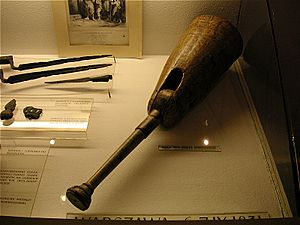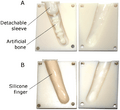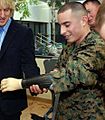Prosthesis facts for kids

A prosthesis (say: pross-THEE-sis) is a special device. It is made to replace a missing part of the human body. People use prostheses if they are missing a body part. This can happen because of an accident or a health problem. Sometimes, people are also born without a body part.
In the past, prostheses were often made of simple materials like wood. For example, some people used wooden legs. Today, these devices are made from much lighter and stronger materials. Modern prostheses can help people move around better. They can replace parts like a leg below the knee (transtibial) or above the knee (transfemoral). They can also replace an arm below the elbow (transradial) or above the elbow (transhumeral). Scientists are still working hard to make artificial limbs even better. They want them to work almost as well as real body parts. Because of this, many prostheses today are designed for a specific activity or need.
Contents
Prostheses in Sports
Prostheses are very important in sports, especially for athletes with missing limbs. These special devices help them compete at a high level.
Skiing with a Prosthesis
In Para-alpine skiing, athletes use special prostheses. These devices are made to act like an ankle. The way an ankle moves is very important for skiing. A skiing prosthesis is usually only used for skiing. Athletes often have different prostheses for everyday life.
Climbing with a Prosthesis
Prosthetic arms can also be designed for climbing. A veteran named Jaco Van Gass, who had an arm amputation, designed his own special arm. It had a built-in ice pick for climbing Mount Everest. His design also included a battery pack and a heat patch. These kept his remaining arm warm in the cold.
Running with a Prosthesis
The Olympic sprinter Oscar Pistorius also used special prostheses for sports. He ran with carbon fiber blades. Some people debated if these blades gave him an unfair advantage over other runners.
How Prostheses Work
Most traditional prosthetic limbs have three main parts. These parts work together to help the user. They are the socket, the attachment, and the control system.
The Socket
The socket is the part of the prosthesis that connects to the user's body. It fits over the remaining part of their limb. It is very important for the socket to fit perfectly. Doctors often make a mold of the patient's limb to get the best fit. If the socket does not fit well, it can cause serious tissue damage.
The Attachment Mechanism
The attachment mechanism holds the prosthetic limb securely in place. It needs to be comfortable for the user. It also needs to be easy to control. Some attachments use straps to hold the limb on. Others might use suction between the socket and the limb.
The Control System
The way a prosthesis is controlled can be very different from one device to another. Some prostheses are controlled by the user's own movements. The person learns to balance and move with the limb. In other cases, cables are used. The user pulls these cables to make the limb bend or move.
Today, one of the most exciting control systems uses myoelectric signals. These are tiny electrical signals from your muscles. This technology is helping scientists develop prostheses that can be controlled by thought!
Images for kids
-
Actor Owen Wilson gripping the myoelectric prosthetic arm of a United States Marine
-
Sgt. Jerrod Fields, a U.S. Army World Class Athlete Program Paralympic sprinter hopeful, works out at the U.S. Olympic Training Center in Chula Vista, Calif. A below-the-knee amputee, Fields won a gold medal in the 100 meters with a time of 12.15 seconds at the Endeavor Games in Edmond, OK, on June 13, 2009
-
Artificial limbs for a juvenile thalidomide survivor 1961–1965
See also
 In Spanish: Prótesis para niños
In Spanish: Prótesis para niños















